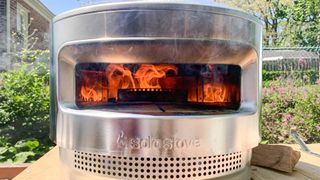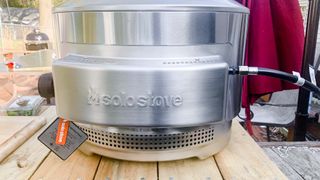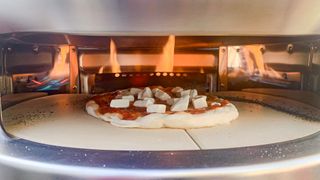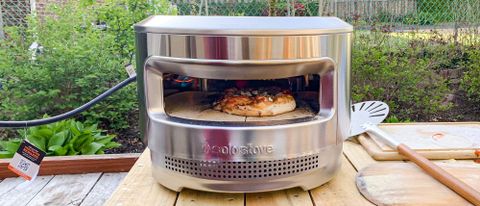Tom's Guide Verdict
The Solo Pi is a great dual-fuel outdoor pizza oven, but we prefer other models if you’re using wood.
Pros
- +
Cooks pizzas well
- +
Dual-fuel oven
- +
Attractive, modern design
Cons
- -
Hard to refuel wood
- -
Can’t control temperature as easily when using wood
Why you can trust Tom's Guide
Size: 20.5 inches (dia), 15.1 inches tall
Weight: 30.5 pounds
Max. pizza size: 12 inches
Stone type/thickness: Cordierite/0.5 inches
Fuel type: Wood/propane
The same company that makes one of the most popular smokeless fire pits is applying its technology to something much more tasty. The Solo Stove Solo Pi is an outdoor pizza oven that can cook pies in as little as two minutes. Starting at $469, it’s affordably priced, and works with both propane and wood. But is it the best pizza oven for your backyard? You’ll want to check out our Solo Pi review — and get hungry reading about all the pizzas we made — before making up your mind.
Solo Pi review: Price and availability
The Solo Pi went on sale in the Spring of 2022, and can be purchased in a few configurations. The oven with just the wood-burning assembly is $469; if you want it with the propane attachment, it will cost $645.
Solo also sells two bundles: The Pi Starter Bundle, which has the wood-burning attachment, an IR thermometer, stainless steel peel, and a pizza cutter, is $554.99; that same bundle with the propane attachment costs $729.99. The Pi Essential bundle, which adds a turning peel and a protective cover for the oven, costs $624.99 for the wood-only model and $794.99 for the wood and gas version.
You can also buy these accessories separately, either through Solo or through some third party. At the very least, I recommend you get a pizza peel — those extra-large spatulas you see at pizzerias — which is an absolute necessity if you want to safely get a pizza in and out of the oven. An infrared or laser thermometer is also handy for knowing just how hot things are inside the oven. Each of these accessories will cost between $20 and $30.
Solo Pi review: Design
The Solo Pi looks a lot like the company’s fire pits. It’s a big, circular stainless steel oven about 20 inches in diameter. A metal grille in the front, just below the oven’s mouth, makes it look like a relative of Gort from The Day the Earth Stood Still.

Still, its design is much more modern than other pizza ovens, and definitely sets the Pi apart. At 30 pounds, it’s fairly light, but not as portable as the Ooni Fyra, another excellent outdoor pizza oven.

There’s a nice large opening in the front; unlike we’ve seen with other pizza ovens, there’s no door, so you get a clear view of your pizza as it’s cooking.

Around the back of the Solo Pi is an opening for the fuel. The Pi comes with an assembly for burning wood, but you can purchase a propane fuel attachment for about $175. You don’t get that nice wood smell, but it makes things a lot easier to manage, especially if you’re new to pizza ovens.
Solo Pi review: Performance
Using the propane attachment, I was able to get the Solo Pi’s internal temperature to around 750 degrees Fahrenheit.

That’s not as hot as some other pizza ovens we tested; I’ve been able to get the Ooni Fyra upwards of 900 degrees, but it was plenty hot enough to make a Neapolitan pie in about two minutes. A half-inch cordierite pizza stone heated up in about 15 minutes, and retained its heat well as we baked half a dozen pizzas.





I used the pizza oven to make around a dozen pizzas, using a 60% hydration Neapolitan dough recipe. Each pizza had a variety of toppings, from a simple margherita to ones with caramelized red onions, sausage, mushrooms, and more. The Pi’s nice wide open mouth made it very easy to monitor the pizza to make sure it wasn’t getting burned, and also made it easy to turn the pizzas in the oven, too.

Even when blazing hot on the inside, the exterior of the Pi remained relatively cool. While hot to the touch, it wasn’t so hot that you’d instantly burn your hand if you were to accidentally touch it.
I also tried out the Solo Pi as a wood-burning pizza oven, as befitting its pedigree. However, I found it cumbersome to use. In order to add wood to the oven, you have to walk around to its backside and remove a panel. You can’t easily add wood through the front of the oven, either, as there’s a metal baffle between the fire box and the main part of the oven.

Like its fire pits, the Solo Pi is very efficient at burning wood, so you’ll be restocking the Pi’s fire box every five to 10 minutes. If you’re trying to feed a crowd, and have to keep going to the back of the oven to add more wood, this could get tiring, quickly.

By comparison, the Ooni Fyra uses wood pellets, which you feed into a chute at the back of the oven. Also, the Fyra’s damper makes it easier to control the temperature of the oven by limiting the airflow; the Solo Pi has no such mechanism.

From an aesthetic point of view, the Solo Pi’s front also gets very sooty if you use wood. As there’s no chimney like the Ooni, the mouth of the oven is the only way for heat and smoke to escape.
Solo Pi review: Verdict
The Solo Pi is a great-looking and well-designed pizza oven that can turn out excellent pies in minutes. It’s also light enough that you can easily move it around when you’re not using it, and its wide mouth makes it a cinch to turn pies while they’re cooking.
However, the Solo Pi is not our first choice for wood-burning ovens — for that, you’ll want to check out Ooni’s pellet-fed ovens, which are much easier to feed and control. However, if you opt for the Solo Pi’s propane burner attachment, you won’t be disappointed — and neither will your guests.

Michael A. Prospero is the U.S. Editor-in-Chief for Tom’s Guide. He oversees all evergreen content and oversees the Homes, Smart Home, and Fitness/Wearables categories for the site. In his spare time, he also tests out the latest drones, electric scooters, and smart home gadgets, such as video doorbells. Before his tenure at Tom's Guide, he was the Reviews Editor for Laptop Magazine, a reporter at Fast Company, the Times of Trenton, and, many eons back, an intern at George magazine. He received his undergraduate degree from Boston College, where he worked on the campus newspaper The Heights, and then attended the Columbia University school of Journalism. When he’s not testing out the latest running watch, electric scooter, or skiing or training for a marathon, he’s probably using the latest sous vide machine, smoker, or pizza oven, to the delight — or chagrin — of his family.
